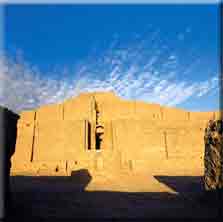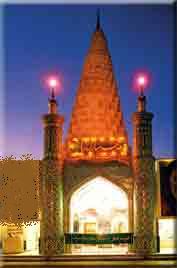|
Khuzestan
 Province Province
Khuzestan
is a part of the historical land of Mesopotamia (between two rivers) in
Iran. Due to its antiquity, this region holds several ancient historical
monuments. Zigorat temple in Chogha Zanbil is a distinct monument
belonging to Elamite civilization of which the foundation dates back to
mid 13 th century BC. In archeological excavations made in Haft Tappeh ,
the remains of palaces, inscriptions, and statues of Elamite time were
discovered. ,
the remains of palaces, inscriptions, and statues of Elamite time were
discovered.
In
Susa (Shoosh) city, in addition to existence of the Shrine of Danial
Nabe (Danial, the Prophet), which is a local place of pilgrimage,
visiting the ruins of ancient Shoosh city is possible. The remaining
monuments in Masjed Solaymand and Sheeshtar belong to Achaemenian,
Parthian, and Sassanide time, which have their own value.
The
old water mills of Shooshtar and brick buildings in Dezfool are the
samples of ancient architectural and technical skills in these cities.
View
Tours this Province click
here

  Hormozgan,
Boushehr, Sistan and Balouchistan Province Hormozgan,
Boushehr, Sistan and Balouchistan Province
The
southern coastlines of Iran have passed several ups and downs along the
history. In recent years, the tourism potentials in these regions have
been paid due attention. Cities of Bandar Abbas and Boushehr, as new  regional centers, represent samples of combination of new and
traditional urban texture of coastal cities (ports) beside each other.
Hormozgan province and its capital city Bandar Abbas, is an
international strategic region for transportation and trade as well as
enjoying beautiful beaches.
regional centers, represent samples of combination of new and
traditional urban texture of coastal cities (ports) beside each other.
Hormozgan province and its capital city Bandar Abbas, is an
international strategic region for transportation and trade as well as
enjoying beautiful beaches.
Boushehr
province is one of the southern provinces of Iran and is located in the
south of Fars province. There are in that province many interesting
ancient and historical monuments of which the most important one is the
historical building of Goor-e-Dokhtar, which belongs to Achaemenian era. The
people of this province are kind and its beautiful coasts are very
attractive especially in winters, the existing historical monuments in
Bandar Syraf that once was a thriving city and a commercial port in
Sassanide times. reflect the briskness of trade in this period.
The
famous islands of Hormoz with old castle and water storage; Qeshm with
ample ancient and local worth-seeing places; and finally Kish with great
tourism facilities and historical monuments like Harireh City and
traditional water reservoirs, are amongst important tourism focal points
in southern coastlines of Iran.
Sistan
and Baluchistan province, which is located in southeast of Iran, is one
of ancient provinces and centers of Iranian civilization. The old
historical monuments of this province, especially ruins of
Shahr-e-Sookhteh (Burned City) close to Khajoo Mountain, have global
fame. Handicrafts of this province are interesting as well. There are
several wildlife habitats in this province of which Sarbaz River, the
habitat of Iranian crocodiles, is famous.
View
Tours this Province click
here

Qom Province
Covering an area of 14,631 square kilometers Qom Province is located in the south of Tehran Province on a low plain. Qom as the capital of the province is located 150 kilometers far from Tehran. The shrine of Her Holiness Masoumeh the sister of His Holiness Imam Reza is located in this city.
The population of Qom Province was 853,000 in 1994 of which 91.16% were urban dwellers, 8.82% were registered as villagers and remaining were non- residents.
Qom province is located in the boundary of central desert (kavir) of Iran. From topographical point of view, this province is consisting of three mountainous, mountain slope, and plain areas. Qom City enjoys a dry and relatively warm climate with low annual rainfall due to remoteness from the sea and being situated in the vicinity of desert. The most lands of the province surround the salt lake and are not cultivable. Except summers that it is hot, other seasons are suitable for traveling to Qom. It is tolled that Qom is a pre-Islamic city, but some believe that it was founded as a city after Islam- ' "Kom" was the name of the ancient wall of the city so, Arabs called this city Qom.
The
souvenirs of Qom are: Sohan Chamous local sweet stony and plaster
handicrafts, ceramic and decorative articles and silk carpet.
View
Tours this Province
click
here

|

 Province
Province ,
the remains of palaces, inscriptions, and statues of Elamite time were
discovered.
,
the remains of palaces, inscriptions, and statues of Elamite time were
discovered. regional centers, represent samples of combination of new and
traditional urban texture of coastal cities (ports) beside each other.
Hormozgan province and its capital city Bandar Abbas, is an
international strategic region for transportation and trade as well as
enjoying beautiful beaches.
regional centers, represent samples of combination of new and
traditional urban texture of coastal cities (ports) beside each other.
Hormozgan province and its capital city Bandar Abbas, is an
international strategic region for transportation and trade as well as
enjoying beautiful beaches.